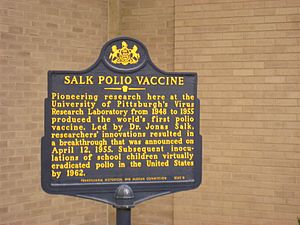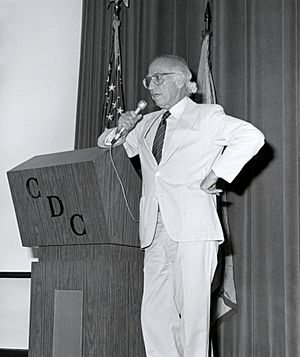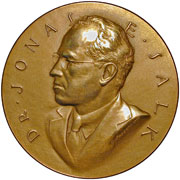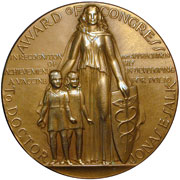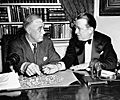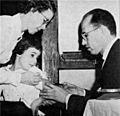Jonas Salk facts for kids
Quick facts for kids
Jonas Salk
|
|
|---|---|
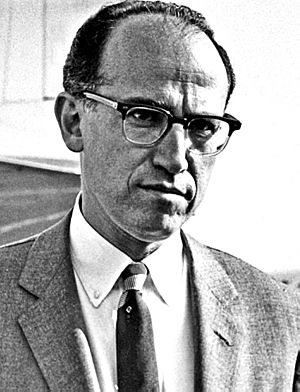
Jonas Salk at Copenhagen Airport (May 1959)
|
|
| Born |
Jonas Edward Salk
October 28, 1914 |
| Died | June 23, 1995 (aged 80) La Jolla, California, U.S.
|
| Resting place | El Camino Memorial Park San Diego, California |
| Alma mater | City College of New York New York University University of Michigan |
| Known for | First polio vaccine |
| Spouse(s) |
Donna Lindsay
(m. 1939; div. 1968) |
| Awards | Lasker Award (1956) |
| Scientific career | |
| Fields | Medical research, virology, and epidemiology |
| Institutions | University of Pittsburgh Salk Institute University of Michigan |
| Doctoral advisor | Thomas Francis, Jr. |
| Signature | |
 |
|
Jonas Edward Salk (October 28, 1914 – June 23, 1995) was an American medical researcher and virologist. He discovered and developed one of the first successful polio vaccines.
Contents
Early life and education
Jonas Salk was born in New York City to Daniel and Dora (née Press) Salk. His parents were Jewish. Jonas had two younger brothers, Herman and Lee, a child psychologist.
As a child, Salk did not show any interest in medicine or science in general. He said in an interview with the Academy of Achievement, "As a child I was not interested in science. I was merely interested in things human, the human side of nature, if you like, and I continue to be interested in that."
When he was 13, Salk entered Townsend Harris High School, a public school for intellectually gifted students, earning a Bachelor of Science degree in chemistry in 1934 from City College of New York (CCNY).
After graduating from CCNY, Salk enrolled in New York University School of Medicine. During his years at New York University Medical School, Salk worked as a laboratory technician during the school year and as a camp counselor in the summer.
Early laboratory work
In 1941, during his postgraduate work in virology, Salk chose a two-month elective to work in the Thomas Francis' laboratory at the University of Michigan. Francis had recently joined the faculty of the medical school after working for the Rockefeller Foundation, where he had discovered the type B influenza virus. According to Bookchin, "the two-month stint in Francis's lab was Salk's first introduction to the world of virology—and he was hooked." After graduating from medical school, Salk began his residency at New York's prestigious Mount Sinai Hospital, where he again worked in Francis's laboratory. Salk then worked at the University of Michigan School of Public Health with Francis, on an army-commissioned project in Michigan to develop an influenza vaccine. He and Francis eventually perfected a vaccine that was soon widely used at army bases, where Salk discovered and isolated one of the strains of influenza that was included in the final vaccine.
Polio vaccine
Until 1955, when the Salk vaccine was introduced, polio was considered one of the most frightening public health problems in the world. In the postwar United States, annual epidemics were increasingly devastating. The 1952 U.S. epidemic was the worst outbreak in the nation's history. Of nearly 58,000 cases reported that year, 3,145 people died and 21,269 were left with mild to disabling paralysis, with most of its victims being children.
The public reaction was likened to a plague, citizens of urban areas were terrified every summer when this disease returned. According to a 2009 PBS documentary, "Apart from the atomic bomb, America's greatest fear was polio." As a result, scientists were in a frantic race to find a way to prevent or cure the disease. In 1938, U.S. President Franklin D. Roosevelt, the world's most recognized victim of the disease, had founded the National Foundation for Infantile Paralysis (known as the March of Dimes Foundation since 2007), an organization that would fund the development of a vaccine.
In 1947, Salk accepted an appointment to the University of Pittsburgh School of Medicine. In 1948, he undertook a project funded by the National Foundation for Infantile Paralysis to determine the number of different types of polio virus. Salk saw an opportunity to extend this project towards developing a vaccine against polio, and, together with the skilled research team he assembled, devoted himself to this work for the next seven years.
The field trial set up to test the Salk vaccine was, according to O'Neill, "the most elaborate program of its kind in history, involving 20,000 physicians and public health officers, 64,000 school personnel, and 220,000 volunteers." Over 1,800,000 school children took part in the trial. When news of the vaccine's success was made public on April 12, 1955, Salk was hailed as a "miracle worker" and the day almost became a national holiday. Around the world, an immediate rush to vaccinate began, with countries including Canada, Sweden, Denmark, Norway, West Germany, the Netherlands, Switzerland, and Belgium planning to begin polio immunization campaigns using Salk's vaccine.
Salk campaigned for mandatory vaccination, claiming that public health should be considered a "moral commitment." His sole focus had been to develop a safe and effective vaccine as rapidly as possible, with no interest in personal profit. Salk's last years were spent searching for a vaccine against HIV. His personal papers are stored at the University of California, San Diego Library.
Establishing the Salk Institute
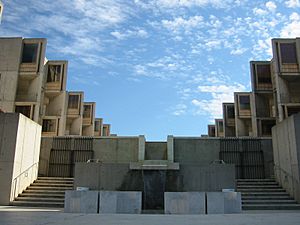
In the years after Salk's discovery, many supporters, in particular the National Foundation, "helped him build his dream of a research complex for the investigation of biological phenomena 'from cell to society'." Called the Salk Institute for Biological Studies, it opened in 1963 in the San Diego neighborhood of La Jolla, in a purpose-built facility designed by the architect Louis Kahn. Salk believed that the institution would help new and upcoming scientists along in their careers, as he said himself, "I thought how nice it would be if a place like this existed and I was invited to work there."
Personal life
The day after his graduation from medical school in 1939, Salk married Donna Lindsay, a master's candidate at the New York College of Social Work. They had three children: Peter, Darrell, and Jonathan Salk. In 1968, they divorced and, in 1970, Salk married French painter, Françoise Gilot.
Jonas Salk died from heart failure at the age of 80 on June 23, 1995, in La Jolla, and was buried at El Camino Memorial Park in San Diego.
Honors and recognition
- 1955, one month after the vaccine announcement, he was honored by the Commonwealth of Pennsylvania, where he was given the Meritorious Service Medal
- 1955, City University of New York creates the Salk Scholarship fund which it awards to multiple outstanding pre-med students each year
- 1956, awarded the Lasker Award
- 1957, the Municipal Hospital building, where Salk conducted his polio research at the University of Pittsburgh, is renamed Jonas Salk Hall
- 1958, awarded the James D. Bruce Memorial Award
- 1958, elected to the Polio Hall of Fame, which was dedicated in Warm Springs, Georgia
- 1975, awarded the Jawaharlal Nehru Award and the Congressional Gold Medal
- 1976, awarded the Academy of Achievement's Golden Plate Award
- 1976, named the Humanist of the Year by the American Humanist Association
- 1977, awarded the Presidential Medal of Freedom from President Jimmy Carter
- 1996, the March of Dimes Foundation created an annual $250,000 cash "Prize" to outstanding biologists as a tribute to Salk
- 2006, the United States Postal Service issued a 63-cent Distinguished Americans series postage stamp in his honor
- 2007, California Governor Arnold Schwarzenegger and First Lady Maria Shriver inducted Salk into the California Hall of Fame
- Schools in Arizona, Washington, Oklahoma, Illinois, New York, New Jersey, Indiana, and California are named after him
- 2012, October 24, in honor of his birthday, has been named "World Polio Day", and was originated by Rotary International over a decade earlier
- 2014, On the 100th anniversary of Salk's birth, a Google Doodle was created to honor the physician and medical researcher
Images for kids
-
Magazine photo of Jonas Salk to O'Neill, "the most elaborate program of its kind in history, involving 20,000 physicians and public health officers, 64,000 school personnel, and 220,000 volunteers," with over 1.8 million school children participating in the trial. A 1954 Gallup poll showed that more Americans knew about the polio field trials than could give the full name of the President.
-
With David Ben-Gurion in Jerusalem, 1959
-
Salk's bronze bust in the Polio Hall of Fame
See also
 In Spanish: Jonas Salk para niños
In Spanish: Jonas Salk para niños


